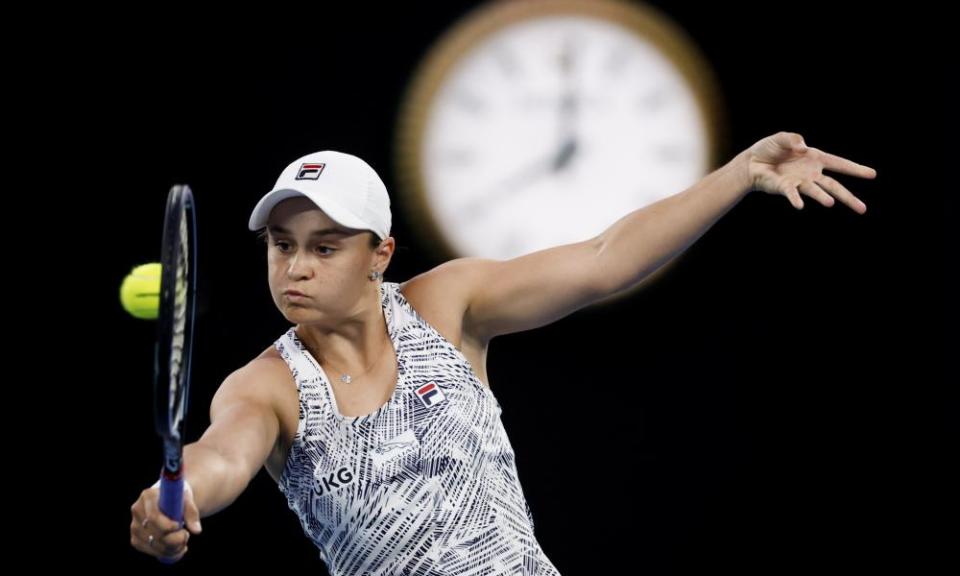Ash Barty determined not to let the weight of history drag her down

Home pressure is a concept of legendary status at the Australian Open. Just ask Sam Stosur. Or Lleyton Hewitt. Or Pat Rafter. Each and every year a new number is added to the same statistic. As long as 1978 gets a mention the picture is painted, the inglorious drought of Australia’s players at their home grand slam once again wrenched from the history books and hoisted about as high as that trophy might be had anyone actually won the thing recently.
Being 2022, it is now 44 years since Christine O’Neil did, on grass, at Kooyong. Ash Barty, of course, knows all of this. Her results of the past three years here read: quarter-final, semi-final, quarter-final. She too would have felt the infamous squeeze in her chest of an expectant country behind her.
Related: Danielle Collins: the late-blooming American on the brink of tennis glory
Not that Barty would speak publicly about it – or at all, for all we know. She is a self-described “creature of habit”. She keeps her powder dry. Nice and predictable. And, predictably, having now sat atop the world rankings for more than two-and-a-half years, the 25-year-old is quite some distance above the rest of the women’s singles field.
Similarly, as anticipated, she is playing it cool and channelling Billie Jean “pressure is a privilege” King. “Absolutely embrace it,” Barty said. “You have to. It’s fun. It’s brilliant to be playing in the business end of your home slam. I’m not gonna lie about that. It’s amazing.
“Being able to experience it multiple times has been incredible, but Saturday’s going to be a new experience for me. So I go out there and embrace it, smile, try and do the best that I can and whatever happens, happens.”
Few would bet against her beating Danielle Collins in the final. The American has been a feelgood story this tournament, and she too is making a point of embracing her first experience of a major final after making a semi-final statement against the Polish seventh seed Iga Swiatek.
“She’s an exceptional ball-striker,” Barty said of Collins. “She’s someone who stands on the baseline and can hit all spots of the court from any position. I think the challenge is going to be trying to get her off-balance.”
One might imagine Barty might get her off-balance in much the same way as she ended the run of Collins’s compatriot, Madison Keys, in one hour and two minutes in her own semi-final on Thursday.
Add that the Queenslander has won 20 straight sets and 81 of her last 82 service games. She has, according to Lindsay Davenport, champion here in 2000, “Serena-esque” service numbers.

Tennis, however, is more than a numbers game, and Barty is more than a toolbox of statistics. She is a person full of quiet confidence, with a small but tight-knit team around her. She is also a Ngarigo woman, and the first Indigenous player to contest an Australian Open final since Evonne Goolagong Cawley won it over four consecutive years between 1974 and 1977.
Last year, when Barty won Wimbledon – her second slam crown – exactly 50 years after Goolagong Cawley’s own Wimbledon title, she hoped she had “made Evonne proud”. The very next day Goolagong Cawley, a Wiradjuri woman, offered her own tribute to her “little sister”, having sensed it was “her time”.
Her time was then, and it is also now. That triumph at the All England Club was felt on the other side of the world, in a country still reckoning with racial inequality. It was a high-profile nod to the 500 different First Nations peoples who make up what is officially called Australia. To repeat the achievement at home may, it is hoped, further assist a reshaping of the public discourse.
Goolagong Cawley, who is a mentor to Barty, will not be present at centre court. But O’Neil is a confirmed Rod Laver Arena attendee, and joked with media this week she has “enjoyed being a good trivia question”. “But I’d be happy to hand it over to her,” she said, “because she is so deserving of it.” She may even get to meet her.
Barty herself is also well-versed in history. Unlike Wendy Turnbull, the last Australian woman to reach the final in 1980, it is highly unlikely that she will play her decider in front of Elton John. It is less likely still that a ball boy will hand-deliver her a note reading “you can do it, love Elton.”
Related: Medvedev overcomes meltdown to beat Tsitsipas and reach Australian Open final
Tennis was a different game back then, and Kooyong was nothing like today’s slick facility that is Melbourne Park. But while Barty is the quintessential modern-day champion, she is firmly connected with her past. “I love Kooyong, I’m a Kooyong girl,” she said. “That’s my club down here in Melbourne. I love the grass there. I’m yet to be able to really enjoy a full grass-court season at the Kooyong courts.
“I can just imagine what it would have been like, the way that the stadium is set up. I’ve said a couple of times I wish I was maybe born in a different era and I got to experience playing on grass courts all year long. It would have been incredible.
“But the development that has come with moving to Melbourne Park has been incredible to encourage fans to come and enjoy it with us. Obviously the courts, the way the game has changed over the last 20, 30 years has been incredible as well.”
Or 44 years.

 Yahoo Movies
Yahoo Movies 